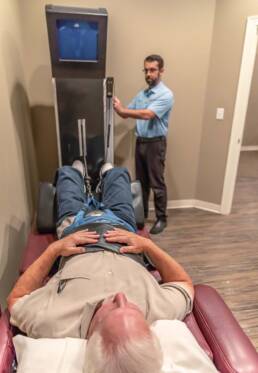Neck injuries can be quite scary. No one seems to truly understand the role the neck plays in how the human body functions until the neck gets injured or starts causing discomfort.
Among all the kinds of injuries that can happen in the neck portion of the skeletal system, whiplash is the most common and well-known kind of injury. It’s a painful injury that can vary from minor to significant in magnitude. In minor cases of whiplash, the list of treatment options includes a lot of “home remedies.” As the magnitude of the whiplash injury increases, the treatment options trend towards more invasive options. In the severest cases, surgery might be required.
For the purposes of this writing, the focus is going to fall on moderate whiplash and the three best non-invasive methods of treating whiplash at this level.
Defining Whiplash
Whiplash can be defined as any combination of injuries to the spine (C1-C3), disks between the vertebrae, ligaments, muscles, nerves, and other soft tissues of the neck. The condition typically occurs when the neck is forcibly thrown backward and then forward in quick succession.
The most common causes of whiplash are rear-ending collisions during a car accident, contact sports injuries, and physical abuse or assault. The symptoms of whiplash include the following:
- Chronic neck pain and or stiffness
- Increase in pain with sudden neck movements
- Loss of range of motion in the neck
- Onset of headaches at the base of the neck
- Tendernous in the shoulders and upper arms
- Onset of numbness and tingling along the arms
- Dizziness due to headaches and loss of blood flow to the head
- General sense of fatigue
- Blurred vision and ringing in the ears
- Concentration difficulties
- and more
3 Treatment Option for Whiplash
As we indicated above, the severity of whiplash can vary wildly. The magnitude of your whiplash condition should serve as the basis for choosing the right treatment option. Given the wide range of possible treatment options, we would like to provide you with information about treating a mild to moderate whiplash condition as non-invasively as possible. Here are three (3) whiplash treatment options that are worthy of your consideration.
1. Stabilizing the Neck
If a majority of whiplash injuries involve the soft tissue areas of the neck, it’s quite possible the tissue can mend on its own. In order for that to happen, the neck would need to be stabilized.
Surely, you have seen the whiplash victim who is entering the courtroom with a big thick brace around their neck. This is typically done for more than effect. A good foam brace will definitely keep the neck stabilized if used properly.
To be honest, today’s orthopedic doctors are trending more toward not wearing a neck brace under the theory the neck will heal faster with good blood flow. If neck braces have limitations, it would be that they do slightly interfere with the flow of blood throughout the body.
While doctors appear to be siding on one or the other side of using a brace to promote healing, they are still being prescribed when neck soft tissue is in question. Braces can also help fractured vertebrae heal faster with mobilization.
2. Pain Medications
If there is a chance whiplash will heal with limited medical intervention, the patient would still be left dealing with the pain until it does heal. In such cases, a physician might elect to prescribe pain medication as their preferred whiplash treatment method.
The key to using this option is applying the treatment method at bedtime. When a person with whiplash is trying to sleep, the pain can be excruciating, often interrupting the sleeping process. The last thing the whiplash victim wants to do is be thrashing about due to restlessness. Strong pain medication should keep them relaxed and perhaps help them sleep.
In the worst of cases, a lidocaine injection can provide pain relief long enough for an individual to start doing strengthening exercises, which might be necessary as the healing process progresses.
3. Chiropractic Treatments
The first two options mentioned here would fall under the purview of medical professionals. With that said, a good chiropractor may have a few whiplash treatment options they can use to deliver faster and better results.
It’s important you understand that the use of certain chiropractic techniques might be a tad bit painful. However, you can have confidence knowing your chiropractor would only put you through the process if they truly believed it would deliver the desired results. The reality is a chiropractor will likely employ several different techniques to provide the following benefits:
- Muscle relaxation techniques to relieve neck tension
- Strengthening exercises to strengthen the injured area or areas
- Massage techniques to improve blood flow to the injured area or areas
- Minor structural alignments to ensure the body’s skeletal system stays in balance
- Heat and cold treatment techniques to help speed up the healing process
Please rest assured that your chiropractor will take all the necessary precautions to ensure your safety during the treatment process.
If you feel you might be experiencing the symptoms of whiplash, you need to seek help as soon as possible. Failure to do so could serve to let the injury get worst over time.
If you would like to know more about our approach to treating whiplash, we would like to encourage you to contact our treatment facility at your earliest convenience. You can reach one of our representatives by Phone at (936) 756-3747 or through our website.

Ready for a complimentary consultation? Get in touch today!
Much like an engineer, we focus on setting up your body to do the activities that you want to do most. An engineer would make sure a bridge could accommodate Houston traffic, and we will make sure your body can accommodate your favorite sport, family activity, or your next adventure.
Like this article? Spread the word!
Related Posts
April 15, 2025
Spring Into Wellness at Freedom Chiropractic: Your Path to Optimal Health Starts Here
Experience pain relief and enhanced wellness this spring at Freedom Chiropractic in…
December 15, 2024
How Chiropractic Care Supports Your New Year’s Resolutions in 2025
Achieve your New Year's resolutions in 2025 with Freedom Chiropractic in Conroe, TX.…
November 15, 2024
Top 7 Exercises to Relieve Back Pain for Conroe Residents
Discover the top 7 exercises to relieve back pain for Conroe residents! Learn expert tips…



